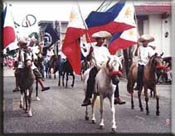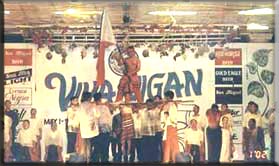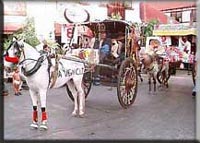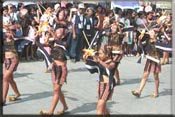|

Held every 8th day of September, the City of Vigan joins
other World Heritage Sites to promote the conservation of natural
and man-made heritage for the benefit of mankind.
In the entire Philippine archipelago, it is only Vigan
City that celebrates this momentous event.
 In
an effort to increase public awareness of Vigan as a unique historic
city to be conserved and protected, the Save Vigan Ancestral Homes
Association, Inc. (SVAHAI), a local non-government organization
involved in the conservation of Vigan Heritage, initiated the 1st
Viva Vigan Festival of the Arts in May 1993. With the help of members
of print and broadcast media, as well as Manila-based proponents
of conservation, the first festival was a success. In
an effort to increase public awareness of Vigan as a unique historic
city to be conserved and protected, the Save Vigan Ancestral Homes
Association, Inc. (SVAHAI), a local non-government organization
involved in the conservation of Vigan Heritage, initiated the 1st
Viva Vigan Festival of the Arts in May 1993. With the help of members
of print and broadcast media, as well as Manila-based proponents
of conservation, the first festival was a success.
Encouraging public response has made festival a yearly activity.
It has also proven to be a stimulus for the local tourism industry.
Over the past years, the Viva Vigan Festival has become one of the
biggest cultural events in the North, attracting domestic and foreign
visitors who come to Vigan on a pilgrimage to our heritage.
Viva Vigan is held every 1st week of May. It features a calesa
parade, binatbatan street dancing, ramada games, religious rituals,
santacruzan, bankathon, exhibits, trade/food fairs, abel-iloco fashion
show and other exciting events.
For many years now, Calesa Parade became the main attraction of
the Viva Vigan Festival of the Arts. It features around 100 calesa
(horse-drawn vehicle) decorated with indigenous materials in accordance
to the theme of the Viva Vigan.


 Introduced
in Viva Vigan 2002 as one of the highlights of the celebration,
Binanbatan Street Dancing is as colorful and interesting as other
street dancing in the country. Binatbatan is a dance using a pair
of bamboo sticks. Introduced
in Viva Vigan 2002 as one of the highlights of the celebration,
Binanbatan Street Dancing is as colorful and interesting as other
street dancing in the country. Binatbatan is a dance using a pair
of bamboo sticks.
Its movements depict the process of producing yarn from the cotton
plant which is use in the abel iloco weaving industry. It features
the young and old bigueños wearing an abel iloco costume
and together dancing across the historic streets of Vigan City.
|